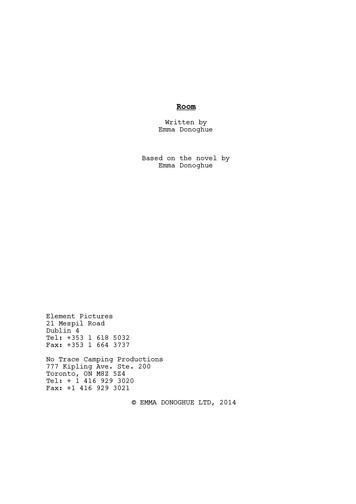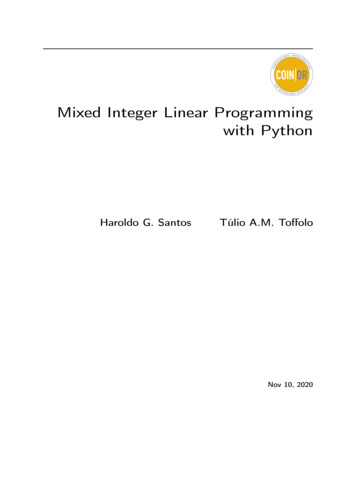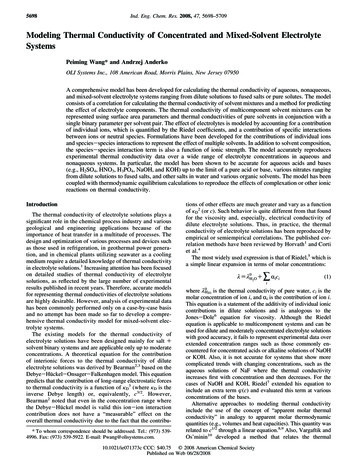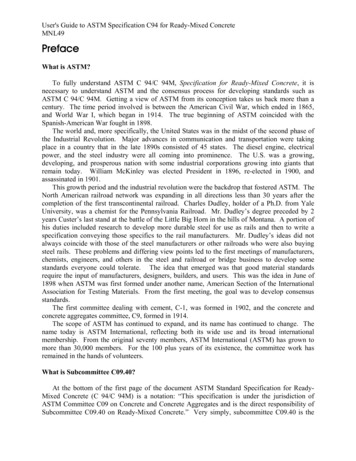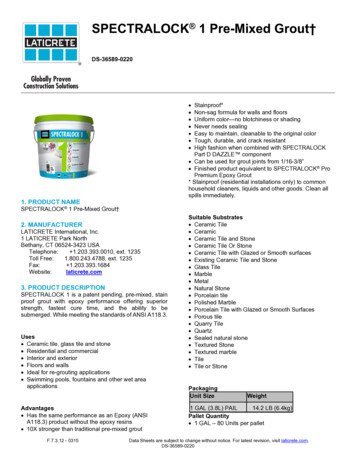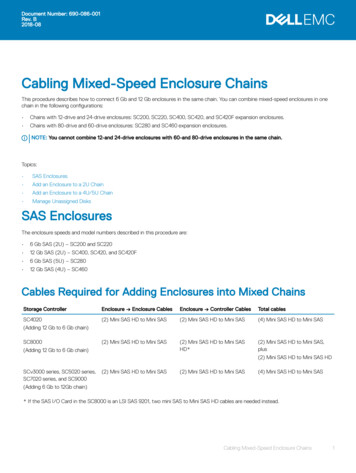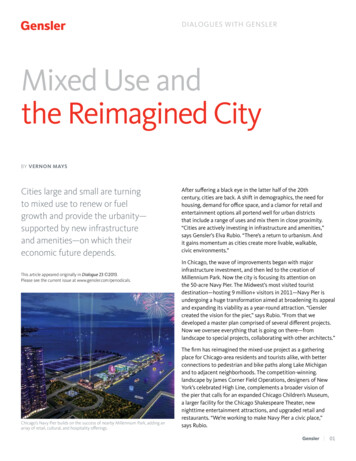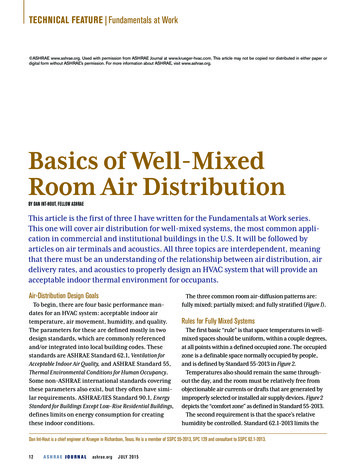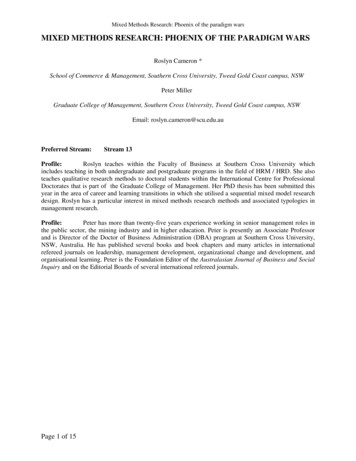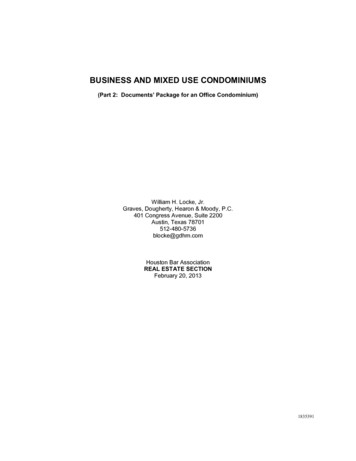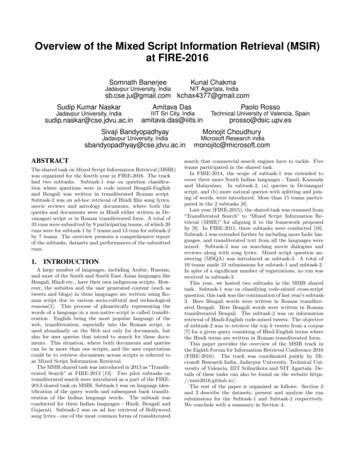
Transcription
Overview of the Mixed Script Information Retrieval (MSIR)at FIRE-2016Somnath BanerjeeKunal ChakmaJadavpur University, IndiaNIT Agartala, Indiasb.cse.ju@gmail.com kchax4377@gmail.comSudip Kumar NaskarAmitava DasPaolo RossoJadavpur University, IndiaIIIT Sri City, IndiaTechnical University of Valencia, inprosso@dsic.upv.esSivaji BandyopadhyayMonojit ChoudhuryJadavpur University, IndiaMicrosoft Research ft.comABSTRACTThe shared task on Mixed Script Information Retrieval (MSIR)was organized for the fourth year in FIRE-2016. The trackhad two subtasks. Subtask-1 was on question classification where questions were in code mixed Bengali-Englishand Bengali was written in transliterated Roman script.Subtask-2 was on ad-hoc retrieval of Hindi film song lyrics,movie reviews and astrology documents, where both thequeries and documents were in Hindi either written in Devanagari script or in Roman transliterated form. A total of33 runs were submitted by 9 participating teams, of which 20runs were for subtask-1 by 7 teams and 13 runs for subtask-2by 7 teams. The overview presents a comprehensive reportof the subtasks, datasets and performances of the submittedruns.1.INTRODUCTIONA large number of languages, including Arabic, Russian,and most of the South and South East Asian languages likeBengali, Hindi etc., have their own indigenous scripts. However, the websites and the user generated content (such astweets and blogs) in these languages are written using Roman script due to various socio-cultural and technologicalreasons[1]. This process of phonetically representing thewords of a language in a non-native script is called transliteration. English being the most popular language of theweb, transliteration, especially into the Roman script, isused abundantly on the Web not only for documents, butalso for user queries that intend to search for these documents. This situation, where both documents and queriescan be in more than one scripts, and the user expectationcould be to retrieve documents across scripts is referred toas Mixed Script Information Retrieval.The MSIR shared task was introduced in 2013 as “Transliterated Search” at FIRE-2013 [13]. Two pilot subtasks ontransliterated search were introduced as a part of the FIRE2013 shared task on MSIR. Subtask-1 was on language identification of the query words and subsequent back transliteration of the Indian language words. The subtask wasconducted for three Indian languages - Hindi, Bengali andGujarati. Subtask-2 was on ad hoc retrieval of Bollywoodsong lyrics - one of the most common forms of transliteratedsearch that commercial search engines have to tackle. Fiveteams participated in the shared task.In FIRE-2014, the scope of subtask-1 was extended tocover three more South Indian languages - Tamil, Kannadaand Malayalam. In subtask-2, (a) queries in Devanagariscript, and (b) more natural queries with splitting and joining of words, were introduced. More than 15 teams participated in the 2 subtasks [8].Last year (FIRE-2015), the shared task was renamed from“Transliterated Search” to “Mixed Script Information Retrieval (MSIR)” for aligning it to the framework proposedby [9]. In FIRE-2015, three subtasks were conducted [16].Subtask-1 was extended further by including more Indic languages, and transliterated text from all the languages weremixed. Subtask-2 was on searching movie dialogues andreviews along with song lyrics. Mixed script question answering (MSQA) was introduced as subtask-3. A total of10 teams made 24 submissions for subtask-1 and subtask-2.In spite of a significant number of registrations, no run wasreceived in subtask-3.This year, we hosted two subtasks in the MSIR sharedtask. Subtask-1 was on classifying code-mixed cross-scriptquestion; this task was the continuation of last year’s subtask3. Here Bengali words were written in Roman transliterated Bengali. Here Bengali words were written in Romantransliterated Bengali. The subtask-2 was on informationretrieval of Hindi-English code-mixed tweets. The objectiveof subtask-2 was to retrieve the top k tweets from a corpus[7] for a given query consisting of Hind-English terms wherethe Hindi terms are written in Roman transliterated form.This paper provides the overview of the MSIR track inthe Eighth Forum for Information Retrieval Conference 2016(FIRE-2016). The track was coordinated jointly by Microsoft Research India, Jadavpur University, Technical University of Valencia, IIIT Sriharikota and NIT Agartala. Details of these tasks can also be found on the website https://msir2016.github.io/.The rest of the paper is organized as follows. Section 2and 3 describe the datasets, present and analyze the runsubmissions for the Subtask-1 and Subtask-2 respectively.We conclude with a summary in Section 4.
2.SUBTASK-1: CODE-MIXED CROSSSCRIPT QUESTION ANSWERINGBeing a classic application of natural language processing, question answering (QA) has practical applications invarious domains such as education, health care, personalassistance, etc. QA is a retrieval task which is more challenging than the task of common search engines because thepurpose of QA is to find accurate and concise answer toa question rather than just retrieving relevant documentscontaining the answer [10]. Recently, the code-mixed crossscript QA research problem was formally introduced in [3].The first step of understanding a question is to perform question analysis. Question classification is an important task inquestion analysis which detects the answer type of the question. Question classification helps not only filter out a widerange of candidate answers but also determine answer selection strategies [10]. Furthermore, it has been observed thatthe performance of question classification has significant influence on the overall performance of a QA system.Let, Q {q1 , q2 , . . . , qn } be a set of factoid questions associated with domain D. Each question q : hw1 w2 w3 . . . wp i,is a set of words where p denotes the total number of wordsin a question. The words, w1 , w2 , w3 , . . . , wp , could be English words or transliterated from Bengali in the code mixedscenario. Let C {c1 , c2 , . . . , cm } be the set of questionclasses. Here n and m refer to the total number of questionsand question classes respectively.The objective of this subtask is to classify each given question q i Q into one of the predefined coarse-grained classescj C. For example, the question “last volvo bus kokhonchare?” (English gloss: “When does the last volvo bus depart?”) should be classified to the class ‘TEMPORAL’.2.1DatasetsWe prepared the datasets for subtask-1 from the datasetdescribed in [3] which is the only dataset available for codemixed cross-script question answering research. The datasetdescribed in [3] contains questions, messages and answersfrom the sports and tourism domains in code-mixed crossscript English–Bengali. The dataset contains a total of 20documents from two domains, namely sports and tourism.There are 10 documents in the sports domain which consistof 116 informal posts and 192 questions, while the 10 documents in the tourism domain consist of 183 informal postsand 314 questions. We initially provided 330 labeled factoidquestions as the development set to the participants after accepting the data usage agreement. The testset contains 180unlabeled factoid questions. Table 1 and Table 2 providestatistics of the dataset. Question class specific distributionof the datasets is given in Figure 1.Table 1: MSIR16 Subtask-1 DatasetsDataset Questions(Q) Total Words Avg. ubmissionsA total of 15 research teams registered for subtask-1. However, only 7 teams submitted runs and a total of 20 runswere received. All the teams submitted 3 runs except AMRITA CEN who submitted 2 runs.Table 2: Subtask-1: Question class statisticsClassTraining TestingPerson (PER)5527Location (LOC)2623Organization neous(MISC)58Figure 1: Classwise distribution of datasetAMRITA CEN [2] team submitted 2 runs. They usedbag-of-words (BoW) model for the Run-1. The Run-2 wasbased on Recurrent Neural Network (RNN). The initial embedding vector was given to RNN and the output of RNNwas fed to logistic regression for training. Overall, the BoWmodel outperformed the RNN model by almost 7% ons F1measure.AMRITA-CEN-NLP [4] team submitted 3 runs. Theyapproached the problem using Vector Space Model (VSM).Weighted term based on the context was applied to overcomethe shortcomings of VSM. The proposed approach achievedupto 80% accuracy in terms of F1-measure.ANUJ [15] also submitted 3 runs. The author used termfrequency âĂŞ inverse document frequency (TF-IDF) vector as feature. A number of machine learning algorithms,namely Support Vector Machines (SVM), Logistic Regression (LR), Random Forest (RF) and Gradient Boosting wereapplied using Grid Search to come up with the best parameters and model. The RF model performed the best amongthe 3 runs.BITS PILANI [5] submitted 3 runs. Instead of applying the classifiers on the code-mixed cross-script data, theyconvert the data into English. The translation was performed using Google translation API 1 . Then they appliedthree machine learning classifiers for each run, namely Gaussian Naı̈ve Bayes, LR and RF Classifier. However, GaussianNaive Bayes classifier outperformed the other two classifiers.IINTU [6] was the best performing team. The team submitted 3 runs which were based on machine learning approaches. They trained three separate classifiers namely RF,One-vs-Rest and k-NN, followed by building an ensembleclassifier using these 3 classifiers for the classification task.The ensemble classifier took the output label by each of the1https://translate.google.com/
individual classifiers and selected the majority label as output. In case of tie any one label was chosen at random asoutput.NLP-NITMZ [12] submitted 3 runs of which 2 runs wererule based - a first set of direct rules were applied for theRun-1 while a second set of dependent rules were used for theRun-3. A total of 39 rules were identified for the rule basedruns. Naı̈ve Bayes classifier was used in Run-2 whereasNaı̈ve Bayes updateable classifier was used in Run-3.IIT(ISM)D used three different machine learning basedclassification models - Sequential Minimal Optimization, Naı̈veBayes Multimodel and Decision Tree FT to annotate thequestion text. This team submitted the runs after the deadline.2.3ResultsIn this section, we define the evaluation metrics used toevaluate the runs submitted to the subtask-1. Typically, theperformance of a question classifier is measured by calculating the accuracy of that classifier on a particular test set[10]. We also used this metric for evaluating the code-mixedcross-script question classification performance.accuracy number of correctly classified samplestotal number of testset samplesIn addition, we also computed the standard precision, recall and F1-measure to evaluate the class specific performances of the participating systems. The precision, recalland F1-measure of a classifier on a particular class c aredefined as follows:number of samples correctly classified as cprecision(P ) number of samples classified as crecall(R) number of samples correctly classified as ctotal number of samples in class cF 1 measure 2.P.RP RTable 3 presents the performance of the submitted runs interms of accuracy. Class specific performances are reportedin Table 4. A baseline system was also developed for thesake of comparison using the BoW which obtained 79.444%Table 3: Subtask-1: Teams N-NLPAMRITA-CEN-NLPAMRITA-CEN-NLPAnujAnujAnujBITS PILANIBITS PILANIBITS IT(ISM)D*IIT(ISM)D*IIT(ISM)DRun t373547374848413439343649333034464638363836* denotes late cy. It can be observed from Table 3 that the highestaccuracy (83.333%) was achieved by the IINTU team. Theclassification performance on the temporal (TEMP) classwas very high for almost all the teams. However, Table 4 andFigure 2 suggest that the miscellaneous (MISC) questionclass was very difficult to identify. Most of the teams couldnot identify the MISC class. The reason could be very lowpresence(2%) of MISC class in the training dataset.3.SUBTASK-2:INFORMATION RETRIEVAL ON CODE-MIXED HINDI-ENGLISHTWEETSThis subtask is based on the concepts discussed in [9].In this subtask, the objective was to retrieve Code-MixedHindi-English tweets from a corpus for code-mixed queries.The Hindi components in both the tweets and the queriesare written in Roman transliterated form. This subtaskdid not consider cases where both Roman and Devanagariscripts are present. Therefore, the documents in this case aretweets consisting of code-mixed Hindi-English texts wherethe Hindi terms are in Roman transliterated form. Given aquery consisting of Hindi and English terms written in Roman script, the system has to retrieve the top-k documents(i.e., tweets) from a corpus that contains Code-Mixed HindiEnglish tweets. The expected output is a ranked list of thetop twenty (k 20 here) tweets retrieved from the given corpus.3.1DatasetsInitially we released 6,133 code-mixed Hindi-English tweetswith 23 queries as the training dataset. Later we releaseda document collection containing 2,796 code-mixed tweetsalong with with 12 code-mixed queries as the testset. Queryterms are mostly named entities with Roman transliteratedHindi words. The average length of the queries in the training set is 3.43 wo
was organized for the fourth year in FIRE-2016. The track had two subtasks. Subtask-1 was on question classi ca- tion where questions were in code mixed Bengali-English and Bengali was written in transliterated Roman script. Subtask-2 was on ad-hoc retrieval of Hindi lm song lyrics, movie reviews and astrology documents, where both the queries and documents were in Hindi either written in De .
